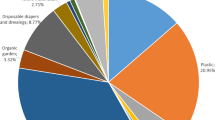Abstract
In this study, environmental impacts of industrial waste disposal of used lubricating oils and sulphur wastes scenarios have been investigated and modeled. The life-cycle assessment methodology was selected among the environmental impact assessment methods. In this method environmental issues and burdens were quantitated in order to facilitate the comparison. In this regard, options with the least adverse impacts were suggested. Functional unit of the study has also been defined as amount of used lubricating oils and sulphur wastes in terms of kilograms based on capacity of transitional barrel. Accordingly, the system boundaries were selected for life cycle of the wastes produced in sulphur unit of Tehran Oil Refinery. Since the main disposal method applied in Tehran Oil Refinery was transference to the municipal landfill, two incineration and landfilling scenarios were modeled for used lubricating oils and sulphur wastes by means of Simapro-7.1 software. Then, the outputs of these scenarios were compared in terms of the least environmental impacts by EDIP 2003 and Ecoindicator 99 methods. Finally, incineration scenarios were recommended as the most efficient ones.





Similar content being viewed by others
References
Al-Salem SM (2009) Life cycle assessment of municipal solid waste management in the state of Kuwait. Eur J Sci Res 34(3):395–405
Chen HW, Yu RF, Liaw SL, Huang WC (2010) Information policy and management framework for environmental protection organization with ecosystem conception. Int J Sci Tech 7(2):313–326
Curran MA (2006) Environmental life cycle assessment. National risk management research laboratory, office of research and development, U.S. Environmental protection agency, EPA/600/R-92/245, McGraw-Hill, New York
Dando DA, Martin DE (2003) A guide for reduction and disposal of waste from oil refineries and marketing installations. CONCAWE/6/03. Brussel
DOE (1995) Oil refineries and bulk storage of crude oil and petroleum products, department of the environment industry profile. Crown copyright
Elshorbagy W, Alkamali A (2005) Solid waste generation from oil and gas industries in United Arab Emirates. J Hazard Mater 120(2):89–99
Epstein PR, Slber J (2002) Oil/life cycle analysis of its health and environmental impacts. The center for health and global environment Publishing Chge Web. http://www.med.harvard.edu/chge/oil.html
Finnveden G, Johansson J, Lind P, Moberg A (2000) Life cycle assessment of energy from solid waste. fms/2000/R-2/137. FOA Repro, Ursvik
Goedkoop M, Schryver AD, Oele M (2008) Introduction to LCA with Simapro. Product ecology consultants (Pre), Pre/2008/4.2
Guereca LP, Gasso S, Baldasano JM, Guerrero PJ (2006) Life cycle assessment of two biowaste management systems for Barcelona. Resour Conserv Recycl 49(1):32–48
Guinee JB (2002) Handbook on life cycle assessment, operational guide to the ISO standards. Kluwer Academic, Dordrecht
Guinee JB (2011) Life cycle assessment: past, present, and future. Environ Sci Technol 45(1):90–96
ISO 14041 (1998) Environmental management-life cycle assessment: goal and scope definition and inventory analysis. International Organisation for Standardization, Geneva
ISO 14042 (2000) Environmental management-life cycle assessment: life cycle impact assessment. International Organisation for Standardization, Geneva
Levan SL (2007) Life cycle assessment: measuring environmental impact. Int J Life Cycle Ass 12(1):61
Liamsanguan C, Gheewala SH (2007) LCA: a decision support tool for environmental assessment of MSW management systems. J Environ Manage 87(1):132–138
Monavari SM (2009) Management and design of urban solid wastes collection. Jihad Daneshgahi Amir Kabir Industrial Unit, Tehran
Nouri N, Poorhashemi SA, Monavari SM, Dabiri F, Hassani AH (2011) Legal criteria and executive standards of solid waste disposal subjected to solid waste management act. Int J Environ Res 5(4):971–980
Ortiz M, Raluy RG, Serra L, Uche J (2006) Life cycle assessment of water treatment technologies: wastewater and water-reuse in a small town. J Desalination 204(2):121–131
Tehrani SM, Karbassi AR, Monavari SM, Mirbagheri SA (2010) Role of e-shopping management strategy in urban environment. Int J Environ Res 4(4):681–690
White N, Clift R, Holmes P, Basson L, Weston N (2011) Streamlined life cycle approaches for use at oil refineries and other large industrial facilities. Ind Eng Chem Res 50(3):1624–1636
Zaman AU (2010) Comparative study of municipal solid waste treatment technologies using life cycle assessment method. Int J Sci Tech 7(2):225–234
Acknowledgments
The authors wish to extend their sincere gratitude to PRẻ Consultant Institute who provided the appropriate software and to the Graduate School of the Environment and Energy, Tehran Science and Research Branch, IAU.
Author information
Authors and Affiliations
Corresponding author
Rights and permissions
About this article
Cite this article
Nouri, J., Nouri, N. & Moeeni, M. Development of industrial waste disposal scenarios using life-cycle assessment approach. Int. J. Environ. Sci. Technol. 9, 417–424 (2012). https://doi.org/10.1007/s13762-012-0076-0
Received:
Accepted:
Published:
Issue Date:
DOI: https://doi.org/10.1007/s13762-012-0076-0




